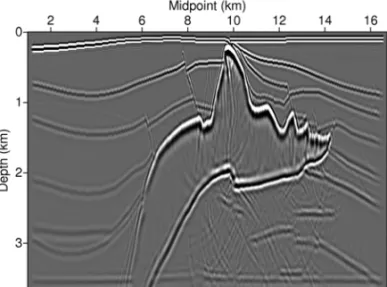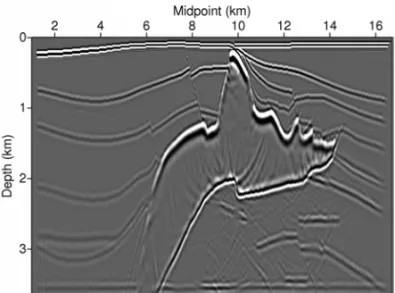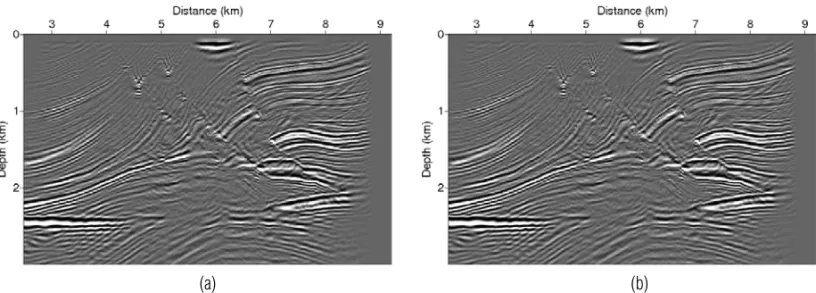www.scielo.br/rbg
WAVE EQUATION DEPTH MIGRATION USING COMPLEX PAD ´E APPROXIMATION
Reynam C. Pestana
1, Jacira C.B. Freitas
2and Jess´e C. Costa
3Recebido em 26 setembro, 2008 / Aceito em 16 janeiro, 2009 Received on September 26, 2008 / Accepted on January 16, 2009
ABSTRACT.We propose a new method of depth migration based on a constant density variable velocity wave equation in the space-frequency domain. A complex Pad´e approximation of the wave equation evolution operator is used for wavefield extrapolation. This method mitigates the inaccuracies and instabilities due to evanescent waves and produces images with fewer numerical artifacts than those obtained with a real Pad´e approximation of the exponential operator, mainly in media with strong velocity variations. Tests on zero-offset data from the SEG/EAGE salt model and the 2D Marmousi prestack dataset show that the proposed migration method can handle strong lateral variations and also has a good steep dip response. We compare the results of the proposed method with those obtained using split-step Fourier (SSF), phase shift plus interpolation (PSPI) and Fourier finite-difference (FFD) methods.
Keywords: depth migration, one-wave equation, complex Pad´e approximation, prestack migration.
RESUMO.Propomos um novo m´etodo de migrac¸˜ao em profundidade baseado na soluc¸˜ao da equac¸˜ao da onda com densidade constante no dom´ınio da freq¨uˆencia. Uma aproximac¸˜ao de Pad´e complexa ´e usada para aproximar o operador de evoluc¸˜ao aplicado na extrapolac¸˜ao do campo de ondas. Esse m´etodo reduz as imprecis˜oes e instabilidades devido `as ondas evanescentes e produz imagens com menos ru´ıdos num´ericos que aquelas obtidas usando-se a aproximac¸˜ao de Pad´e real para o operador exponencial, principalmente em meios com fortes variac¸˜oes de velocidades. Testes em dados de afastamento nulo do modelo de sal SEG/EAGE e nos dados de tiro comum 2-D Marmousi foram realizados. Os resultados obtidos mostram que o m´etodo de migrac¸˜ao proposto consegue lidar com fortes variac¸˜oes laterais e tamb´em tem uma boa resposta para refletores com mergulhos ´ıngremes. Os resultados foram comparados `aqueles resultados obtidos com os m´etodos split-step Fourier (SSF), phase shift plus interpolarion (PSPI) e Fourier diferenc¸as-finitas (FFD).
Palavras-chave: migrac¸˜ao em profundidade, equac¸˜ao unidirecional da onda, aproximac¸˜ao de Pad´e complexa, migrac¸˜ao pr´e-empilhamento.
1Institute of Physics & Research Center in Geophysics and Geology, Federal University of Bahia, Salvador, BA, Brazil. Phone: +55 (71) 3283-8521; Fax: +55 (71) 3283-8551 – E-mail: reynam@cpgg.ufba.br
2Institute of Physics & Research Center in Geophysics and Geology, Federal University of Bahia, Salvador, BA, Brazil. Phone: +55 (71) 3263-6689 Extension no.: 6614; Fax: +55 (71) 3235-5592 – E-mail: jacira@cpgg.ufba.br
INTRODUCTION
Wave equation migration methods perform better imaging than ray-based migration methods in media with strong lateral velocity variations. The majority of wave equation methods are based on solving one-way acoustic wave equation. There are many diffe-rent methods to numerically solve a given one-way wave equa-tion. These methods can be grouped into three classes: Fourier methods (Stoffa et al., 1990; Gazdag & Sguazzero, 1984) sol-ved in the wavenumber domain; finite-difference methods (FD) (Claerbout, 1985; Hale, 1991) and mixed methods that are a li-near combination of spectral and Fourier finite-difference methods (FFD) (Ristow & R¨uhl, 1994). In both FD and FFD migration methods, the purely real Pad´e approximation or a simple Taylor expansion is usually used to approximate the square-root opera-tor. Real operators cannot handle evanescent waves (Millinazzo et al., 1997), to deal with this problem they proposed a complex Pad´e approximation.
The complex Pad´e expansion was previously used in ap-plied geophysics. Zhang et al. (2003) used the method in finite-difference migration however its implementation was not efficient for wide-angle migration. Zhang et al. (2004) derived a split-step complex Pad´e-Fourier solution for one-way equation using both [1/1] and [2/2] Pad´e approximations. Recently, Amazonas et al. (2007) used the complex Pad´e approximation for wide-angle FD and FFD prestack depth migration. These works show that com-plex Pad´e approximation mitigates the inaccuracy and instability due to evanescent waves.
We use the exact acoustic wave equation to derive the down-ward continuation operator, instead of starting from an one-way wave equation. The propagation of the wavefield from one depth level to the next is carried out by the complex Pad´e approxima-tion of the exact downward continuaapproxima-tion operator. The discreti-zed approximation of this operator produces a tridiagonal linear system which is solved to obtain the extrapolated wavefield from the previous one.
In the following sections, we derive the FD Pad´e solution for the wave equation using the complex Pad´e approximation. Then we present zero-offset migration results for the SEG/EAGE salt model. Next, the 2D Marmousi dataset is used to test the prestack shot-record depth migration scheme that is developed, based on the FD method using complex Pad´e approximation propagators. The cross-correlation between source and receiver wavefields is applied for prestack imaging condition. A comparison with the standard (real-valued) FD, FFD, Fourier split-step, PSPI and our method is also given. The test results show that our FD migra-tion method is capable of imaging structures with strong lateral
velocity variation.
THEORY AND THE METHOD
The finite-difference solution method is based on a depth extra-polation of the temporally transformed constant density acoustic wave equation given by:
∂2P
∂z2 = −
ω2
c2 P−
∂2P
∂x2 −
∂2P
∂y2 , (1)
whereP(x,y,z, ω)denotes the Fourier transform of the pres-sure field p(x,y,z,t),ωis the temporal frequency, xand y
are the horizontal coordinates,zis the depth andc(x,y,z)is the velocity.
The wave equation may be spatially discretized on a uniform mesh(x,y,z)followed by a selection of a second derivative ap-proximation to transform it into a system of ordinary differential equations (Kosloff et al., 2006) as follows,
d2P(x,y,z, ω)
d z2 = −
ω2
c2
o
D P(x,y,z, ω) , (2)
where,
D= c 2
o c2(x,y,z)+
co2
ω2∇
2 (3)
andco is a constant velocity (usually chosen as the minimum velocity in each layer).
We assume that within each layer(z,z+1z)the velocity is vertically constant. Then the upward propagating solution to (2) within a layer can be formally written as
P(x,y,z+1z, ω)
=expi ω 1z co
√
D P(x,y,z, ω) .
(4)
Introducingδ≡ ω 1z
co , we have
P(x,y,z+1z, ω)=exp(iδ√D) P(x,y,z, ω) . (5)
The operatorDin (3) contains both positive and negative va-lues which respectively correspond to propagating and evanes-cent waves (Kosloff et al., 2006).
A complex treatment of the exponential term is applied to mitigate inaccuracy and instabilities due to the evanescent waves (Milinazzo et al., 1997; Zhang et al., 2004). This can be done using a complex Pad´e approximation of the square root.
Before applying the Pad´e approximation, the branch cut of the square-root is rotated by an angleθ. The operator in equation (5) can be rewritten as
whereδ′=δeiθ/2andD′=D e−iθ−1 . Then
P(x,y,z+1z, ω)=eiδ′ eiδ′Z P(x,y,z, ω) . (7)
where,Z =√D′+1−1 .
Applying Pad´e approximation to√D′+1we have (Zhang, et al., 2003):
Z =√D′+1−1=
N
X
n=1
anD′
1+bnD′, (8)
whereNdefines the order of the Pad´e expansion,anandbnare real-valued coefficients. This expansion permits us to write
eiδ′Z =
N
Y
n=1
exp
i anD′
1+bnD′
. (9)
Considering only the first-order approximation, equation (8) becomes
Z ∼= a1D
′
1+b1D′ =
a D′
1+b D′. (10) wherea = 1/2andb = 1/4for conventional[1/1]Pad´e expansion.
To derive a finite-difference representation of the downward continuation operator, we use the following approximation of the exponential operator in equation (9), which is second-order ac-curate and unitary:
e±i x ∼=1± i x/2
1∓ i x/2. (11)
The continuation operator, equation (7), is then approximated as
P(x,y,z+1z, ω)
=eiδ′ (2+m D
′)
(2+m∗D′)P(x,y,z, ω) .
(12)
where,m = 2b+i aδ′ andm∗its complex conjugate. We implemented this algorithm for 2D case, accordingly,
D=c 2
o c2 +
c2o
ω2
∂2
∂x2. (13)
We use a second-order finite-difference scheme to approxi-mate the partial derivative on a regular grid. Using the notation
Pin≡P(xi,zn, ω), that is given by:
∂2Pin
∂x2 ∼=
Pin+1−2Pin+Pin−1
(1x)2 . (14)
Substituting this finite-difference approximation into equation (12), we obtained after some algebra the linear system
Nx X
j=1
Ai jPin+1=eiδ′ Nx X
j=1
Bi jPin; i=1, . . . ,Nx (15)
whereNxis the number of grid points along thex−coordinate. Using the Kronecker symbolδi,j, the matrices Ai j andBi jcan
be expressed as
Ai j =β′δi,j−α′ δi,j+1+δi,j−1
,
Bi j =βδi,j−α δi,j+1+δi,j−1
,
with
β ≡2+ c
2 0
c2+2
c02
ω2δ2 !
me−iθ,
β′≡2+ c
2 0
c2 +2
c20
ω2δ2 !
m∗e−iθ,
α≡c
2 0
c2me
−iθ, α′≡ c02
c2m ∗e−iθ.
The matrices Ai j and Bi j in equation (15) are tridiagonal. Solving this linear system we can obtainPin+1, the wavefield at
zn+1z, from the known wavefield Pinat depthzn. In conse-quence of equation (9), this scheme can be applied recursively, with appropriate coefficientsanandbn, to include higher-order terms in the extrapolation.
Poststack migration
The inputs to the proposed migration method using the com-plex Pad´e approximation are the zero-offset data and a reasona-ble estimate of the velocity distribution. The wavefield is extra-polated in depth, and the imaging condition is accomplished by the exploding-reflector model. The migrated image is obtained at each depth level by adding all frequencies. The output is a migra-ted depth section in depth domain.
Migration example – SEG/EAGE salt model
Figure 1– SEG/EAGE salt model velocity field.
θ = 0(real Pad´e approximation) and 5 degrees, respectively. Some migration artifact is apparent in the result presented in Fi-gure 2. Takingθ 6= 0(Fig. 3) we obtain a image with fewer evanescent-energy artifacts than those shown in Figure 2. Fi-gure 4 shows the image obtained with SSF method using the average velocity as a reference velocity. Figure 5 was obtained with PSPI using 5 reference velocities and the Figure 6 shows the result with FFD, now using the minimum velocity as a refe-rence velocity. Comparing the SSF (Fig. 4), PSPI (Fig. 5) and FFD (Fig. 6) and the proposed method (Fig. 3), we see that our method also gives good images of the top and base interfaces of the salt body. Moreover, the image in Figure 3 has fewer nume-rical artifacts than those obtained with SSF and FFD migration methods.
Figure 2– Migration result forθ=0◦using real Pad´e approximation.
Figure 3– Migration result forθ=5◦using complex Pad´e approximation.
Figure 5– PSPI migration result using 5 reference velocities.
Figure 6– Fourier finite-difference (FFD) migration result.
Prestack migration
Claerbout (1970, 1971) suggested that prestack migration could be done by summing migrated common shot gathers (profiles). Stolt & Benson (1986) applied the method to marine profiles. In order to migrate shot profiles we need the temporal Fourier transform of the recorded common shot profiles at the surface
PU(x,z = 0, ω), the interval velocity fieldc(x,z)and the shot waveformPD(x,z=0, ω).
The method can be summarized by the following steps (Claer-bout, 1970, 1971):
1) Downward continuation of the source waveform,PD:
PD(x,z+1z, ω)= ˜LsPD(x,z, ω) . (16)
The downward extrapolation operator,Ls˜ , comes from equation (12) and the downward continuation of the source constitutes a forward modeling.
2) Downward continuation of the waveform recorded by re-ceivers at the surfacePU:
PU(x,z+1z, ω)= ˜Lr PU(x,z, ω) . (17)
The downward continuation operator for the receivers,Lr˜, comes from equation (12).
3) Evaluation of the reflectivity functionR, in frequency do-main, can be formulated by the following equations:
PU(x,z+1z, ω)
=PD(x,z+1z, ω)R(x,z+ |1z, ω) . (18)
Multiplying both sides of equation (18) by the complex con-jugate ofPD, we have:
R(x,z+1z, ω)
= PU(x,z+1z, ω)PD
∗(x,z+1z, ω)
PD(x,z+1z, ω)PD∗(x,z+1z, ω).
(19)
If equation (19) is inverse Fourier transform over frequency and imaging condition oft = 0at eachzstep is invoked, it becomes (Claerbout, 1971):
R(x,z+1z)
=X
ω
PU(x,z+1z, ω)PD∗(x,z+1z, ω)
PD(x,z+1z, ω)PD∗(x,z+1z, ω).
(20)
This imaging principle was proposed by Claerbout (1971) and it can find in space those points where upgoing and downgoing waves are time-coincident, which is where reflectors exist. In or-der to cure a zero-divide problem, a small positive numberǫ(z)
can be added to the denominator in equation (20), but it is typi-cally difficult to determine since it is data dependent.
The depth image is often obtained by cross-correlating these two wavefields. For several shots it is given by:
R(x,z+d z)
=X
xs
X
ω
PU(x,z+d z, ω;xs)PD∗(x,z+d z, ω;xs). (21)
2D Marmousi model
Figure 7– Velocity model of 2D Marmousi dataset.
(a) (b)
Figure 8– Comparison of the prestack depth migration results of the 2D Marmousi dataset obtained with the first-order FD complex Pad´e approximation method: (a)θ=0◦ and (b)θ=10◦.
using only the first term of the equation (8). Figures 9a and 9b further show the migration sections with the second- and third-order FD method forθ = 10◦, respectively. The imaging re-sult with the complex Pad´e propagations shows a significant im-provement when compared with the FD imaging results using the real Pad´e propagations. For comparison we also migrated this dataset with the split-step Fourier (SSF) method using the average velocity as a reference velocity (Fig. 10a) and the phase shift plus interpolation (PSPI) algorithm (Fig. 10b) implemented with 8 reference velocities for each depth extrapolation.
The results of FD migration using complex Pad´e approxima-tion in Figure 9 are similar to the image SSF and PSPI. Some
differences between the images are concentrated upper left part of the image, where the FD image lack focusing for the steep reflec-tors associated to the faults. We believe these differences can be reduced with a better choice of the rotation angleθ. Further study is still needed to determine an optimum choice of this parameter for each velocity model.
CONCLUSIONS
(a) (b)
Figure 9– Prestack depth migration result of the 2D Marmousi dataset obtained: (a) with the second-order FD complex Pad´e approximation method forθ =10◦. (b) with third-order FD complex Pad´e approximation method forθ=10◦.
(a) (b)
Figure 10– Migration result obtained with: (a) the split-step Fourier method (b) with the PSPI method (8 reference velocities).
method allows the use of a larger grid spacing in depth. A complex treatment of the propagation operator is used to treat the evanes-cent waves and improve the stability of the numerical approxima-tion. The synthetic results show that high quality images can be obtained with this proposed approach. This technique could be easily extended to the Fourier finite-difference method and also can be improved by using second- or higher-order approximation terms. Further study is still needed to determine the best rotation angle for each velocity model.
ACKNOWLEDGMENTS
This research has been partially supported by the Research Foun-dation of State of Bahia (FAPESB) and the National Research Council (CNPq) of Brazil. We also thank CT-PETRO/CNPq-FINEP for provided funding.
REFERENCES
AMAZONAS D, COSTA JC, PESTANA R & SCHLEICHER J. 2007. Wide angle FD and FFD migration using complex Pad´e approximations, 69th Meeting. EAGE Conference & Exhibition. CD-ROM.
CLAERBOUT JF. 1970. Coarse grid calculations of waves in inhomo-geneous media with application to delineation of complicated seismic structures. Geophysics, 35: 406–418.
CLAERBOUT JF. 1971. Toward a unified theory of reflector mapping. Geophysics, 36: 467–481
CLAERBOUT JF. 1985. Imaging the Earth’s interior. Blackwell Scientific Publications.
GAZDAG J & SGUAZZERO P. 1984. Migration of seismic data by phase shift plus interpolation. Geophysics, 49: 124–131.
MILLINAZZO FA, ZALA CA & BROOKE GH. 1997. Square-root approxi-mations for parabolic equation algorithms. J. Acoust. Soc. Am., 101(2): 760–766.
KOSLOFF D, TAL-EZER H, BARTANA A, RAGOZA E & SHABELANSKY A. 2006. Three dimensional wave equation depth migration by a direc-tion soludirec-tion method. Expanded Abstracts 76thAnn. Inter. Mtg., SEG, 2490–2493.
RISTOW D & R ¨UHL T. 1994. Fourier finite-difference migration. Geo-physics, 59(12): 1882–1893.
STOFFA PL, FOKKEMA JT, LUNA FREIRE RM & KESSIGER WP. 1990. Split-step Fourier migration. Geophysics, 55: 410–421.
STOLT RH & BENSON AK. 1986. Seismic Migration: Theory and prac-tice. Geophysical Press.
ZHANG L, RECTOR JW & HOVERSTEN GM. 2003. Split-step complex Pad´e migration. Journal of Seismic Exploration, 12: 229–236.
ZHANG L, RECTOR JW, HOVERSTEN GM & FOMEL S. 2004. Split-step complex Pad´e-Fourier depth migration. Expanded Abstracts 74thAnn. Inter. Mtg., SEG. 989–992.
NOTES ABOUT THE AUTHORS
Reynam da Cruz Pestanareceived his B.Sc. in Physics in 1984 and his PhD in Geophysics in 1988, both degrees from Federal University of Bahia (UFBA). He was a post-doc at Karlsruhe University from 1988 to 1991 and at the University of Texas at Austin from 1998 to 1999 with grants from CNPq. Presently, he is an Associate Professor at the Department of Physics of the Earth and Environment of the Physics Institute of UFBA. He has experience in Geosciences, with emphasis in Applied Geophysics, working mainly in processing and imaging of seismic and GPR data.
Jacira Cristina Batista de Freitasreceived her B.Sc. in Physics in 1977 and her PhD in Geophysics in 2004, both degrees from Federal University of Bahia (UFBA). Presently, she is an Associate Professor at the Department of Physics of the Earth and Environment of the Physics Institute of UFBA. She has experience in Geosciences, with emphasis in Applied Geophysics, working mainly in theory of GPR data. Her fields of interest include Ray Theory and Gaussian Beam Method, Potential Methods and Mathematical Methods for Geophysicists.



